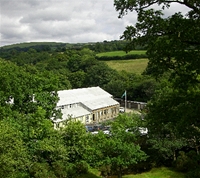Focus on renewable energy
A key component of our drive towards increasing efficiency is our focus on renewable energy. In the South West region we are blessed with some of the UK’s best natural resources for generating clean renewable energy. We can turn some of the rainfall that falls on the higher moors into hydro electricity and, as the second windiest region in the UK, we are also ideally situated for wind turbines, this is on top of being one of the sunniest areas of the UK and an ideal location for solar power.
As well as making use of natural renewable energy resources available by investing in hydro, wind and solar power we also recover energy from the sewage sludge that arrives at our works. We use anaerobic digestion, a process where microorganisms break down sewage sludge in the absence of oxygen, to produce a methane rich biogas. We then use this gas in engines that produce both electricity and heat, helping to offset the amount of energy that we need to purchase from outside sources.
About 10% of the energy we currently use comes from renewable energy sources and we operate some 60 renewable energy installations, these are a mixture of hydro electric power, wind, solar and biogas schemes. We plan to continue to invest in renewable energy and have set ambitious target to source 20% of our energy from renewables by 2020. We plan to achieve this through a strategy that -
-
invests in new renewable energy schemes appropriate to our needs
-
optimises our existing renewable energy plant,
-
collaborates with new or existing third party projects that neighbour our treatment works,
-
works with third party energy suppliers in sourcing green electricity from the electricity grid.
Our longer term goal is to continue to reduce our dependence on fossil fuels and move ever closer towards 100% renewable energy.
Reducing carbon emissions
Our goal is to consistently reduce the climate change causing greenhouse gas emissions that are our responsibility. To this end we measure and publicly report our carbon emissions, setting targets and taking action to reduce emissions wherever possible. We encourage our staff to reduce emissions both at work and at home and work in partnership with suppliers to reduce emissions in our supply chain. We also encourage our customers to be water wise, as only using the water you need will help us to minimise emissions from our activities.
We have a good record on reducing our carbon footprint and are currently on course to meet our 2020 emissions targets. We also understand the importance of playing our part in contributing to the Government’s longer term plans to reduce the UK’s Greenhouse gas emissions in line with the targets set out under the Climate Change Act and the Paris Agreement.
Renewable energy from the moors

Mary Tavy and Morwellham power stations harness the forces of nature to generate three-and-a-half megawatts of green energy for South West Water - enough to power a small town like Tavistock.
Renewable energy comes from sustainable sources: the water that is naturally flowing from a high level back to sea level provides the mechanical power that is converted by the hydro process into electricity. It is 100 per cent renewable and recyclable by our natural weather patterns and is one of the most efficient sustainable energy resources we have today.
There has been a form of hydro-electric power generated at Mary Tavy since 1932. During the last 75 years, the original turbines have gradually been upgraded with the latest technology to meet the latest efficiency standards.
Although the Mary Tavy hydro-electric power station is now small compared with more recent plants, it provides a fascinating insight into how hydro-electric has developed over the decades.

